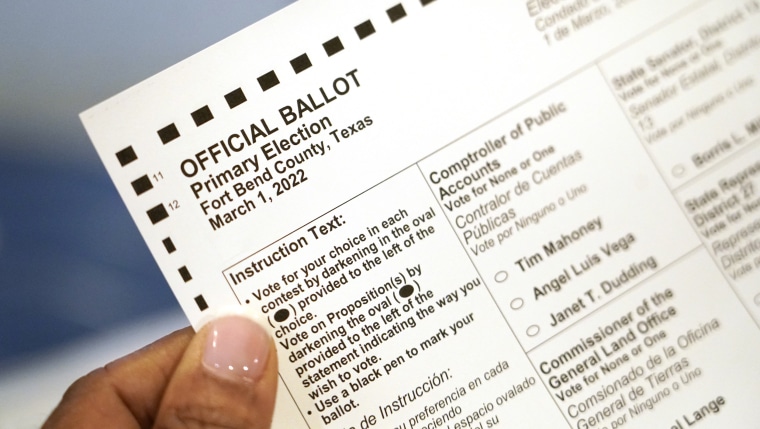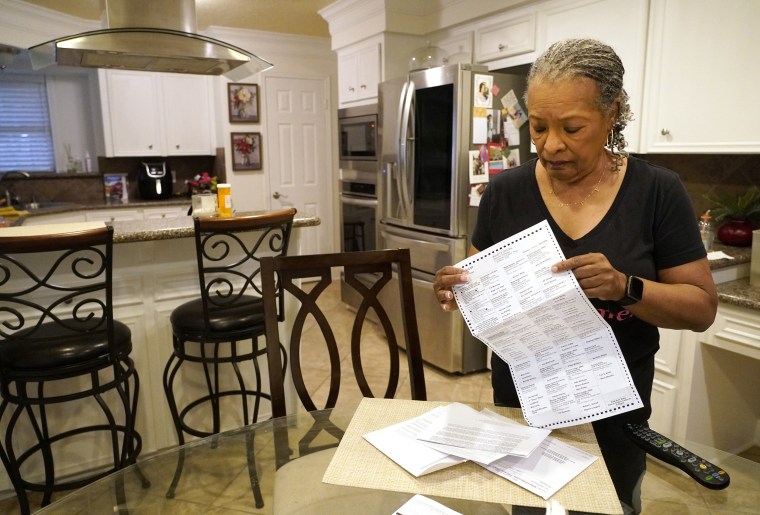New voting rules in Texas are tripping up voters at an unusual rate, putting thousands of ballots at risk of being rejected if voters don't correct them soon, multiple county officials said.
Mail voting kicked off in January ahead of the state's primaries on March 1 — the first contest of the 2022 midterm cycle — with early in-person voting beginning this week. Already, thousands of ballots have failed to meet the state's new identification requirements, according to election officials.
Officials said they are mailing back ballots and sometimes calling and emailing voters to alert them to the problems with an explanation of how those ballots need to be corrected. But they also expressed concerns that many voters won't fix their ballots in time.
In El Paso County, nearly half of all mail ballots returned so far have failed to satisfy new ID requirements, while 35 percent of ballots were flagged for rejection in Harris County for similar reasons, county officials told NBC News.
Republicans in the state Legislature overhauled Texas’ election code last year as former President Donald Trump continued to push the lie that the 2020 presidential election was stolen. Among other changes, voters are now asked to include some form of identification — such as a driver’s license number — on mail ballot applications and the envelope they use to return their completed mail ballots. The law also limited early voting hours and empowered partisan poll watchers.
Texas Democrats fought the new voting law for months, arguing the changes would disenfranchise voters and were unnecessary in light of exhaustive evidence that voter fraud is incredibly rare. (Texas’ own exhaustive hunt for fraud in 2020 closed just 16 minor cases, according to the Houston Chronicle.)
This is the first statewide election since the law, known as Senate Bill 1, was implemented in December, and early data indicates Texans are struggling with the changes.

Harris County, home to the city of Houston and more than 4 million residents, was the first to report a high rejection rate for mail ballots. The county was inundated with thousands of questions about mail voting in January and forced to quickly hire new staff to deal with the surge of work that voter confusion and rejected ballots have created, according to Harris County Elections Administrator Isabel Longoria.
"We have so many eligible, true, good voters who've always been part of the process that are now getting caught up in just this extra layer of bureaucracy," Longoria told NBC News.
As of Tuesday, 9,809 ballots were received by election officials, and of those more than third (3,491) were flagged for errors, according to Longoria. Sixteen were flagged for an issue with their signature, while the other 3,475 ballots were flagged for identification problems. They have been sent back to voters to be corrected.
As of the same day, approximately 14 percent of mail ballot applications were rejected over the ID requirements. That’s double the rate of applications that were rejected during the 2018 midterm election, according to county data.
Sometimes it's as simple as election officials not having a driver's license number on file for a voter yet.
"The classic example: When you registered to vote decades ago, you put your Social Security number, but now when you're doing your mail ballot application, you're putting your driver's license number. Both numbers are true, legal and accurate to the voter, but we are not allowed to match those numbers," Longorio said.
Because of this, the Texas secretary of state’s office recommended that voters include several identification numbers on their ballot applications, according to Remi Garza, president of Texas’ Association of Elections Administrators and the elections administrator for Cameron County, Texas.
If voters don’t include the same numbers on the ballot that they used on their application, officials said their ballots will be rejected.
Garza said not all counties are contacting voters about fixing their ballots in the same ways.
“It’s important to remember that Texas has 254 counties, and each one faces its own unique challenges to implement these new changes,” he said. “The short turnaround time that the Legislature gave to implement it has created its own challenges.”
Cameron County, a south Texas county with more than 400,000 residents, has so far flagged 41 percent of received mail ballots for identification problems, Garza said Thursday.
Voters can correct their ballot applications until Friday, Feb. 18, the deadline for requesting a mail ballot before the March 1 primary; Texans are asked to postmark their mail ballots by 7 p.m. on primary day, but some voters will be able to fix ballot errors as late as March 7.
In El Paso County, home to more than 800,000 residents, approximately 49 percent of mail ballots are being flagged for rejection; election workers are mailing ballots back and calling voters to invite them to fix the error — a process known as curing — in person. But historically, the number of ballot errors that are fixed by voters before the primary tends to be low.
“In general, a small portion will cure their rejected ballots. However, we’ve not seen this many rejected and it depends on the voter,” Lisa Wise, the county’s elections administrator, said.
Travis County, Texas' fifth largest by population, said they were seeing approximately 17 percent of returned ballots flagged for missing ID numbers. Approximately 7 percent of mail ballot applications were rejected, according to Victoria Hinojosa, a spokesperson for the county. Voters are being informed of the errors, she added.
In Montgomery County, Texas, approximately 10 percent of mail ballot applications and ballots have been flagged for rejection, according to county Elections Administrator Suzie Harvey, who said that was approximately 140 ballots. The county is home to more than a million people.
These rejection rates are all significantly higher than typically seen in Texas general elections.
In the 2020 election, nearly a million Texans voted by mail. Just 0.8 percent of voters’ mail ballots, 8,304 ballots, were rejected, according to data compiled by the U.S. Election Assistance Commission. In 2018, 9,377 ballots were rejected for a rate of 1.76 percent.
Some officials observed that absentee ballot application rejection rates were falling over time, suggesting voters were adapting.
“Our rejection rate for absentee mail ballot applications started around 10 percent but after the first batch of them dropped to around 4 percent,” said Bruce Sherbet, elections administrator in Collin County, Texas, which is home to more than a million people.
Similarly, 21 percent of ballot applications were rejected in January in Fort Bend, and 13 percent were rejected in the first week of February, according to John Oldham, elections administrator for Fort Bend County.
He added that the county had already faced delays in sending ballot applications out due to paper supply issues and the time it took to redesign ballot materials to comply with the new law. He said the county didn’t have ballot rejection rates yet but were "definitely" seeing higher reject rates than usual.
While many opponents of the restrictive voting law said it would disproportionately disenfranchise voters of color, Oldham said elderly voters were hit hardest.
“Really, it’s affecting old people. Eight-five percent of ballot-by-mail voters are persons over 65, so they’re the ones that are really adversely affected, whether they’re Republicans or Democrats,” he said. “In fact, in that first month and a half, we rejected more Republican apps than we did Democrat apps.”
Beto O'Rourke, a Democrat seeking to challenge Republican Gov. Greg Abbott in November, slammed the high rejection rates in a statement to NBC News.
“This voter suppression is on purpose and by design, working exactly as Greg Abbott intended," he said, adding that his campaign was working to mobilize voters to ensure their ballots were counted.
Abbott did not respond to a request for comment.

